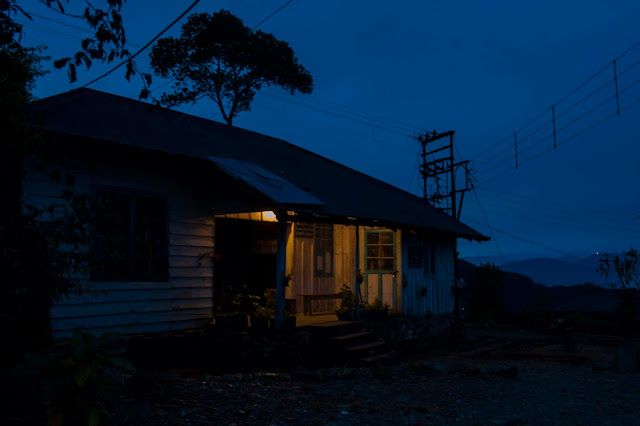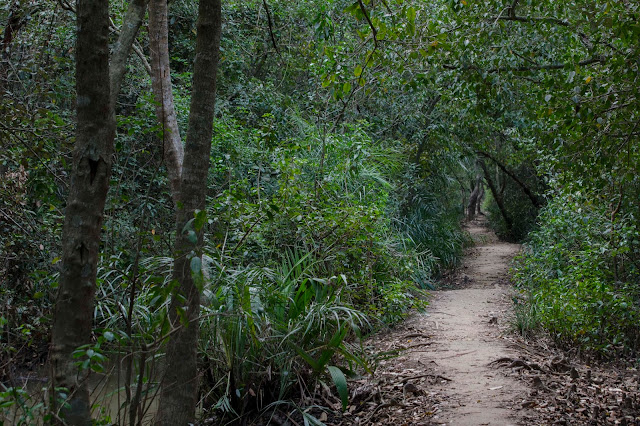Where Trogons Fly: Latpanchar 2019
|| Evening at Nursery ||
“This is where trogons fly.”
The words came almost in whispered tenor, punctuated by silences.
The road turned steep after crossing a sinking zone. Due to a pan abandoned forest project, the place took the name of ‘Nursery’. Darkness covered us long back. The headlight of the Sumo fighting valiantly to keep them away. But the curves, woods and gorges conspired against it to make it fail.
We were not afraid though. Deven is a person to be trusted with - we know him for more than five years now. His chiseled Rai face betrays little emotion, but exudes easy confidence. His superb driving skill matches with his enviable knowledge of Mahananda Wildlife Sanctuary. We believed his words immediately.
“This is where trogons fly.”
The air was still. A forecast of rain was looming large on us. In its anticipation, the trees hushed themselves up, nocturnal life failed to kick in.
Faint lights appeared at distant hill slopes. Latpanchar arrived.
|| Plan over Chicken ||
The knock was polite, hesitant. Tum opened the door.
Parag had grown tall. Five years back, when we saw him last, he was a kid. Finishing up school, had an insatiable hunger towards nature. He has managed to turn himself as one if the best naturalists in this region - no mean feat, considering his young age. But his sharp face remained as innocent as ever.
We walked downstairs. Near the village school we met Padam Gurung, and P C Rai - our hosts. As always, these gentlemen brought in warmth to make us feel at home. We were taken to dining.
I passed on a copy of species wish list to Parag at dining table. The list was scrutinised, some of them stricken off, some added. A plan was chalked out.
Trogon, or more specifically Red-headed Trogon dominated the discussion. After excellent sighting of Malabar Trogon in Western Ghats, our thirst to see its Eastern Himalayan cousin enhanced manifold. Can Latpanchar quench it?
The other bird that prevailed that night over dinner table, was the chicken in the curry. We devoured.
|| Rain Rain, Go Away ||
Once, there was a tree here. In its hollow shell, it used to provide shelter to a pregnant Rufous-necked Hornbill pair every year. The mother used to sit inside the hole with her unhatched eggs, and then with hatched fledglings. The father used to feed them every couple of hours. With its eye level position, it provided an excellent opportunity to witness the drama. A storm fell the tree down few years back.
We walked the trail towards that tree in the morning. The trail was steep. Rain yesterday made them walk more difficult over slippery rocks. On our way, we saw few sulkers - Common Green Magpie, Scimitar Babbler. Overcast sky, and over cautious birds did not give us any opportunity to photograph them.
Down below, a small meadow to give some respite from torturous walk. A solitary Blue-bearded Bee-eater sat on a curve of a bamboo. Bar-winged Flycatcher-shrike, and ?? Minivets played around at bushes nearby.
A leafless tree with brilliant coral flowers stood at the backdrop of drab grey sky. A flock of Rufous Sibia kept themselves busy drinking nectar. We stood expecting arrival of Maroon Oriole. But the sibias did not allow others.
We walked up near a small hut. Call of a flycatcher drifted in. ‘Sapphire Flycatcher’ - Parag confirmed. We stood near a cowshed. On an orange bird arrived with its brilliant blue and rufous plumage.
Mesmerised with its look, we did not notice when cloud rolled down the hill. A downpour ensued. Our feeble shelter turned ineffective. The narrow trail took the shape of a waterfalls. Then an angel saved us from sure shot pneumonia.
The lady of the house opened the door and invited us to come inside. Warm cups of tea arrived. We chatted with Parag about the life in hills especially around the difficult days in monsoon.
The rain continued for a good two and half hours.
|| Fire and Wet Souls ||
The Gumpha was small. Colourful prayer flags flew against evening sky, still covered with clouds. A layer of it went down below the hills creating a cotton quilt covering forest. Rain had gone away though.
Couple of helpful villagers came forward. They had seen a flock of Sultan Tits were there on a tree down the path. But there was hardly any light to photograph them.
A return stroll brought us near the village hospital. Light from its windows created a feeble warm hue at the backdrop of blue evening. A tree over it stood like a sentinel. A day was over.
Parag invited us to join him in meeting one of his relatives. We gladly accepted.
The hostess of the house warmly welcomed us. A fire was lit. We placed our wet trekking shoes near it. Tea and pakora was served. Warmth from the fire and hospitality lifted the mood.
To resonate, the sky opened with bright stars and a crescent moon.
|| Wait and Yearning ||
The morning was bright. A flock of yuhina kept the tree busy. Few wedge tailed green pegions were plucking fruits from another tree. But would we see trogon today?
Parag was hopeful. "Breeding seaaon is coming. They need protein. Because of rain yesterday, they could not hunt. They would be more active today." Sounded a very plausible hypothesis.
Small birds were truly active today. Nuthatches, both chestnut bellied and velvet fronted played on tree branches. A black-lored tit kept close to them.
The road was under repair. Workers erected an asphalt mixing machine near a turn. The place was the typical habitat of scarlet finches. With all the noise and fume, no question of seeing them today.
Few senior birders placed their tripods over the road. We had come near rufous necked hornbill zone. Though they were not in vicinity.
We followed a 'chor-bato' down the slope. Yuhinas were close. So were black crested bulbuls. We went down further and stood under a tree.
Up above, a female hornbill sat on a branch. A distant 'bek' call was clearly audible. The male was not far away.
We sat at a shack above overlooking the tree. Plates of noodles were served. Male came close to female. A flock of rufous necked laughing thrushes foraged on the ground.
Sultan tits, chestnut bellied rock thrushes were found near nuesery. But despite waiting long trogons gave us miss. Our attentive ears did not catch any calls either.
At afternoon nursery was silent. A grey headed canary flycatcher sat at pine only. Some tesias made noises near ground. But those small birds were hardly visible.
Parag picked a faint call. We followed it through a trail down below. Call was closer. But the trogon never came out. We waited till the light left us as well.
Our drive back homestay was silent. We drained all our energy in expectation and yearning. The village evening was quiet as well, as if in our sympathy.
|| Where Trogons Fly ||
The wait was unbearable. Every morning minute is golden in birding. With the planned afternoon departure, it was even more suffocating. Yet we were helpless.
The gang moved near the village, near the cincona warehouse. With fresh tar laden asphalt mixture laid on road, with a road roller to complete the picture, cars were stuck for good 20 minutes for now.
The day started with a beautiful shot of male scarlet minivet, with good exposure at his black head. But our search of a male maroon oriole failed near the coral flower tree failed. Black throated sunbird was captured though in this sunny morning. But Red headed trogon? Would them visit us?
With that quest, Parag and Deven drove us towards nursery yet again. But the road was blocked.
Every nightmare has an end. So had this roadblock. Even the call of rufous necked hornbill could not deter us. Car stopped near the farthest end of trogon territory. Parag alighted first. And he spotted.
A beautiful male trogon sat under canopy. He pondered, tilted his head, flew to catch an insect and come back. He went deeper into forest and came back again. It was unbelievable how silent a bird of his size could be in his flight - silent as a bee-eater. He flaunted beautiful feathers of his handsome tail with equal grace and silence. Mesmerizing.
A call came from other side of the road, down below the gorge. Another male flew out and came in open. But before we could aim him, he flew deep into forest. The first trogon, in his territorial instinct got into a competitive call duel.
A flock of common woodshrikes played on pine tree. Yellow throated martens gave us a miss. A malayan giant squirrel made his appearance under dark foliage. Up above near a turn a barred owlet braved the bright light around and sat peacefully. Groups of assamese macaques and grey langurs were in proximity of each other. Yet they maintained peaceful coexistence.
In the afternoon, while driving to Gazoldoba, we found a chestnut bellied rock thrush after crossing the sinking zone. While following sultan tit call, Parag found an ashy bulbul peeking through leaves.
We were happy. Afternoon sun started to lose its shine. Teesta played hide and seek at every turn. Parag asked Deven to stop the car. He silently opened the front door and pointed us towards a bush. Excitement was evident in his sharp face. We followed his finger and saw another trogon sitting at a small opening of the dark bush. A female, but no less beautiful.
Latpanchar. Where trogons fly.




Comments
Post a Comment